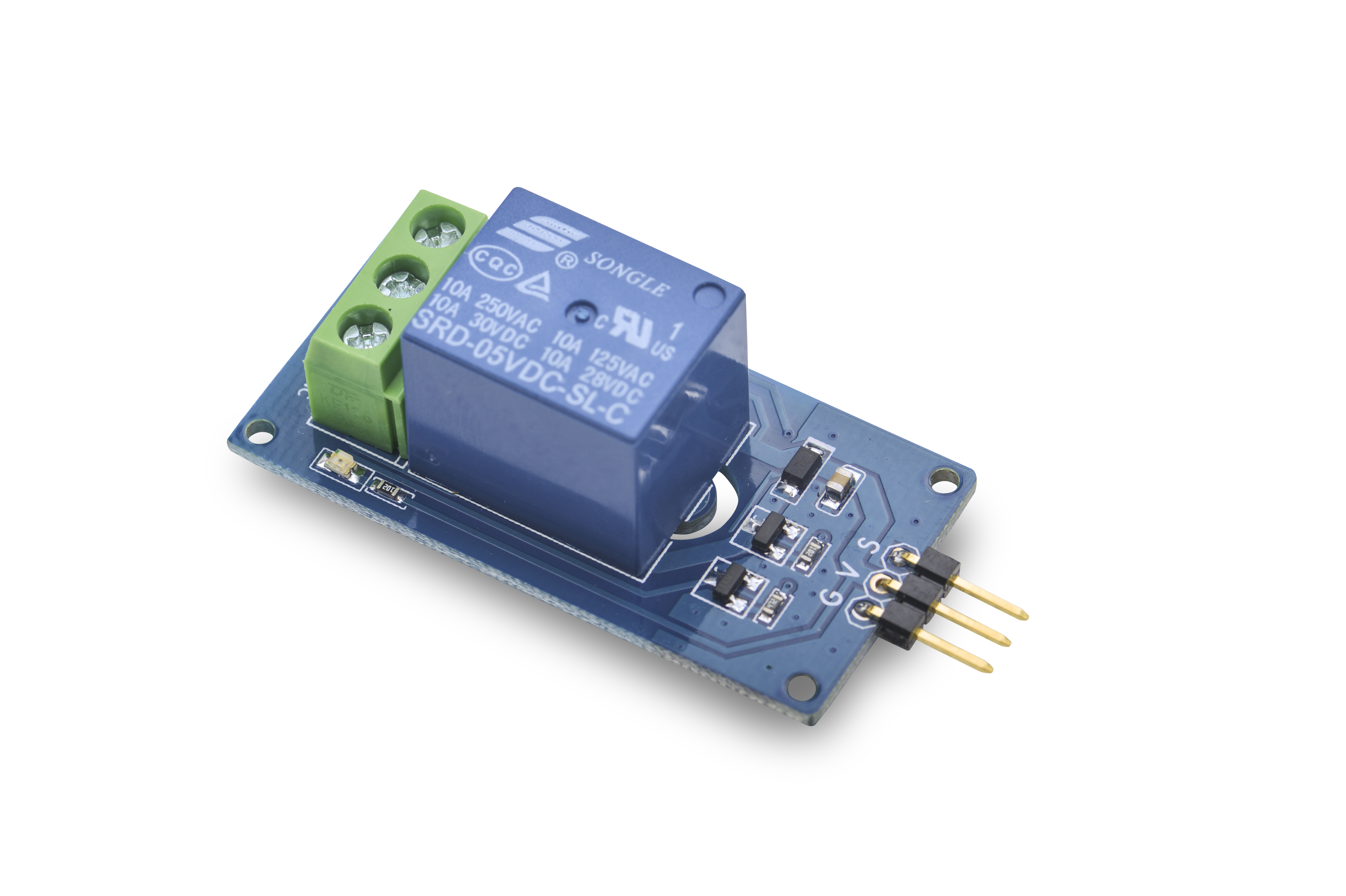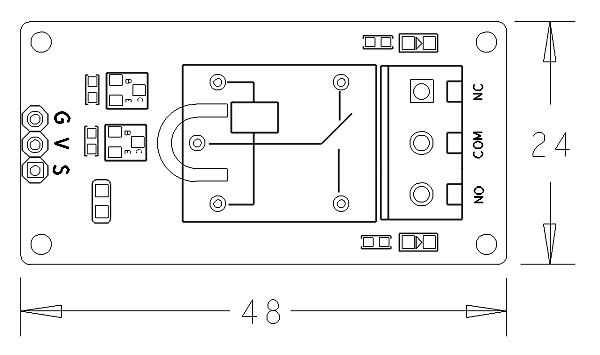Difference between revisions of "Matrix - Relay"
(→Basic Device Operation) |
|||
| (9 intermediate revisions by 2 users not shown) | |||
| Line 29: | Line 29: | ||
This is an SPDT relay. Its supply voltage is 5V and current on-contact is up to 10A. It can drive AC or DC high power loads. NO is Normally Open. NC is Normally Closed. COM is Common. When writing high to pin S NO will be open and NC will be closed. | This is an SPDT relay. Its supply voltage is 5V and current on-contact is up to 10A. It can drive AC or DC high power loads. NO is Normally Open. NC is Normally Closed. COM is Common. When writing high to pin S NO will be open and NC will be closed. | ||
| + | |||
| + | ==Applications== | ||
| + | ===Connect to NanoPi M1=== | ||
| + | Refer to the following connection diagram to connect the module to the NanoPi M1:<br> | ||
| + | [[File:Matrix-Relay_nanopi_m1.jpg|frameless|600px|Matrix-Relay_nanopi_m1]] | ||
| + | |||
| + | Connection Details: | ||
| + | {| class="wikitable" | ||
| + | |- | ||
| + | |Matrix-Relay || NanoPi M1 | ||
| + | |- | ||
| + | |S || Pin7 | ||
| + | |- | ||
| + | |V || Pin4 | ||
| + | |- | ||
| + | |G || Pin6 | ||
| + | |} | ||
| + | |||
| + | ===Connect to NanoPi 2=== | ||
| + | Refer to the following connection diagram to connect the module to the NanoPi 2:<br> | ||
| + | [[File:Matrix-Relay_nanopi_2.jpg|frameless|600px|Matrix-Relay_nanopi_2]] | ||
| + | |||
| + | Connection Details: | ||
| + | {| class="wikitable" | ||
| + | |- | ||
| + | |Matrix-Relay || NanoPi 2 | ||
| + | |- | ||
| + | |S || Pin7 | ||
| + | |- | ||
| + | |V || Pin4 | ||
| + | |- | ||
| + | |G || Pin6 | ||
| + | |} | ||
| + | |||
| + | ===Connect to NanoPi M2 / NanoPi 2 Fire=== | ||
| + | Refer to the following connection diagram to connect the module to the NanoPi M2/ NanoPi 2 Fire:<br> | ||
| + | [[File:Matrix-Relay_nanopi_m2.jpg|frameless|600px|Matrix-Relay_nanopi_m2]] | ||
| + | |||
| + | Connection Details: | ||
| + | {| class="wikitable" | ||
| + | |- | ||
| + | |Matrix-Relay || NanoPi M2 | ||
| + | |- | ||
| + | |S || Pin7 | ||
| + | |- | ||
| + | |V || Pin4 | ||
| + | |- | ||
| + | |G || Pin6 | ||
| + | |} | ||
| + | |||
| + | ===Connect to NanoPC-T2=== | ||
| + | Refer to the following connection diagram to connect the module to the NanoPC-T2:<br> | ||
| + | [[File:Matrix-Relay_NanoPC-T2.jpg|frameless|600px|Matrix-Relay_NanoPC-T2]] | ||
| + | |||
| + | Connection Details: | ||
| + | {| class="wikitable" | ||
| + | |- | ||
| + | |Matrix-Relay || NanoPC-T2 | ||
| + | |- | ||
| + | |S || Pin15 | ||
| + | |- | ||
| + | |V || Pin29 | ||
| + | |- | ||
| + | |G || Pin30 | ||
| + | |} | ||
| + | |||
| + | ==Compile & Run Test Program== | ||
| + | Boot your ARM board with Debian and copy the matrix code: | ||
| + | <syntaxhighlight lang="bash"> | ||
| + | $ apt-get update && apt-get install git | ||
| + | $ git clone https://github.com/friendlyarm/matrix.git | ||
| + | </syntaxhighlight> | ||
| + | If your cloning is done successfully a "matrix" directory will be generated. | ||
| + | |||
| + | Compile and install Matrix: | ||
| + | <syntaxhighlight lang="bash"> | ||
| + | $ cd matrix | ||
| + | $ make && make install | ||
| + | </syntaxhighlight> | ||
| + | |||
| + | Run test program: | ||
| + | <syntaxhighlight lang="bash"> | ||
| + | $ matrix-gpio_out | ||
| + | </syntaxhighlight> | ||
| + | Note: this module is not plug and play therefore before running the module please make sure it is connected to an ARM board.<br> | ||
| + | Here is what you should observe:<br> | ||
| + | <syntaxhighlight lang="bash"> | ||
| + | 1: gpio status change | ||
| + | 2: gpio status change | ||
| + | 3: gpio status change | ||
| + | 4: gpio status change | ||
| + | 5: gpio status change | ||
| + | </syntaxhighlight> | ||
| + | |||
| + | ==Code Sample== | ||
| + | This Matrix code sample can work with all the ARM boards mentioned in this module's wiki. The name of this code sample is "matrix-gpio_out". Here is its source code: | ||
| + | <syntaxhighlight lang="c"> | ||
| + | int main(int argc, char ** argv) | ||
| + | { | ||
| + | int pin = GPIO_PIN(7); | ||
| + | int i, value, board; | ||
| + | int ret = -1; | ||
| + | |||
| + | if ((board = boardInit()) < 0) { | ||
| + | printf("Fail to init board\n"); | ||
| + | return -1; | ||
| + | } | ||
| + | if (board == BOARD_NANOPI_T2) | ||
| + | pin = GPIO_PIN(15); | ||
| + | |||
| + | if (argc == 2) | ||
| + | pin = GPIO_PIN(atoi(argv[1])); | ||
| + | if ((ret = exportGPIOPin(pin)) == -1) { | ||
| + | printf("exportGPIOPin(%d) failed\n", pin); | ||
| + | } | ||
| + | if ((ret = setGPIODirection(pin, GPIO_OUT)) == -1) { | ||
| + | printf("setGPIODirection(%d) failed\n", pin); | ||
| + | } | ||
| + | for (i = 0; i < STATUS_CHANGE_TIMES; i++) { | ||
| + | if (i % 2) { | ||
| + | value = GPIO_HIGH; | ||
| + | } else { | ||
| + | value = GPIO_LOW; | ||
| + | } | ||
| + | if ((ret = setGPIOValue(pin, value)) > 0) { | ||
| + | printf("%d: GPIO_PIN(%d) value is %d\n", i+1, pin, value); | ||
| + | } else { | ||
| + | printf("setGPIOValue(%d) failed\n", pin); | ||
| + | } | ||
| + | sleep(1); | ||
| + | } | ||
| + | unexportGPIOPin(pin); | ||
| + | return 0; | ||
| + | } | ||
| + | </syntaxhighlight> | ||
| + | For more details about this APIs called in this code sample refer to [[Matrix API reference manual]] <br> | ||
| + | <!--- | ||
==Download Matrix Source Code== | ==Download Matrix Source Code== | ||
| − | All the matrix modules' code samples are open source. They are maintained on GitHub - | + | All the matrix modules' code samples are open source. They are maintained on GitHub - https://github.com/friendlyarm/matrix.git <br> |
Each branch in this hub contains the matrix modules' code samples for a board that the matrix modules can work with.<br> | Each branch in this hub contains the matrix modules' code samples for a board that the matrix modules can work with.<br> | ||
* The nanopi branch contains the matrix modules' code samples for the NanoPi | * The nanopi branch contains the matrix modules' code samples for the NanoPi | ||
| + | * The nanopi 2 branch contains the matrix modules' code samples for the NanoPi 2 | ||
* The tiny4412 branch contains the matrix modules' code samples for the Tiny4412 | * The tiny4412 branch contains the matrix modules' code samples for the Tiny4412 | ||
* The raspberrypi branch contains the matrix modules' code samples for the RaspberryPi | * The raspberrypi branch contains the matrix modules' code samples for the RaspberryPi | ||
| Line 44: | Line 182: | ||
Clone the matrix code from GitHub | Clone the matrix code from GitHub | ||
<syntaxhighlight lang="bash"> | <syntaxhighlight lang="bash"> | ||
| − | $ git clone | + | $ git clone https://github.com/friendlyarm/matrix.git |
</syntaxhighlight> | </syntaxhighlight> | ||
If this is successful a "matrix" directory will be generated, which will contain all the matrix modules' code samples. | If this is successful a "matrix" directory will be generated, which will contain all the matrix modules' code samples. | ||
| + | |||
| + | ==Connect to NanoPi 2== | ||
| + | ===Hardware Connection=== | ||
| + | Please refer to the following connection diagram to connect the Matrix-Relay to the NanoPi 2:<br> | ||
| + | [[File:Matrix-Relay_nanopi_2.jpg|frameless|600px|Matrix-Relay_nanopi_2]] | ||
| + | |||
| + | Connection Details: | ||
| + | {| class="wikitable" | ||
| + | |- | ||
| + | |Matrix-Relay || NanoPi 2 | ||
| + | |- | ||
| + | |S || Pin7 | ||
| + | |- | ||
| + | |V || Pin4 | ||
| + | |- | ||
| + | |G || Pin6 | ||
| + | |} | ||
| + | |||
| + | ===Compile Test Program=== | ||
| + | Please login the matrix hub and enter the nanopi2 branch | ||
| + | <syntaxhighlight lang="bash"> | ||
| + | $ cd matrix | ||
| + | $ git checkout nanopi2 | ||
| + | </syntaxhighlight> | ||
| + | |||
| + | Compile the matrix code | ||
| + | <syntaxhighlight lang="bash"> | ||
| + | $ make CROSS_COMPILE=arm-linux- clean | ||
| + | $ make CROSS_COMPILE=arm-linux- | ||
| + | $ make CROSS_COMPILE=arm-linux- install | ||
| + | </syntaxhighlight> | ||
| + | Note: please make sure to install the cross compiler "arm-linux-gcc-4.9.3" on your PC, which is used to compile files for the NanoPi2.<br> | ||
| + | Generated library files are under the "install/lib" directory. Applications are under the "install/usr/bin" directory. The test program for the "Matrix-Relay" module is "matrix-relay".<br> | ||
| + | The driver is under the modules directory and its source code is in github: https://github.com/friendlyarm/linux-3.4.y.git <br> | ||
| + | |||
| + | ===Run Test Program=== | ||
| + | Please insert a TF card which is flashed with Debian to a Linux host and mount its boot and rootfs sections.<br> | ||
| + | We assume the rootfs is mounted to /media/rootfs then please run the following commands to copy the driver, library and test program to the card.<br> | ||
| + | <syntaxhighlight lang="bash"> | ||
| + | $ cp modules /media/rootfs/ -r | ||
| + | $ cp install/lib/* /media/rootfs/lib/ -d | ||
| + | $ cp install/usr/bin/* /media/rootfs/usr/bin/ | ||
| + | </syntaxhighlight> | ||
| + | |||
| + | Insert this TF card to your NanoPi 2, power on and run the following command to start matrix-relay.<br> | ||
| + | <syntaxhighlight lang="bash"> | ||
| + | $ matrix-relay | ||
| + | </syntaxhighlight> | ||
| + | Note: this module is not plug and play therefore before running the module please make sure it is connected to a NanoPi 2. | ||
| + | |||
| + | ===Code Sample=== | ||
| + | <syntaxhighlight lang="c"> | ||
| + | int main(int argc, char ** argv) | ||
| + | { | ||
| + | char *status = "off"; | ||
| + | if (argc != 2) { | ||
| + | printf("Set relay on\n"); | ||
| + | } else { | ||
| + | status = argv[1]; | ||
| + | printf("Set relay %s\n", argv[1]); | ||
| + | } | ||
| + | |||
| + | int pin = GPIO_PIN(7); | ||
| + | int ret = -1; | ||
| + | if ((ret = exportGPIOPin(pin)) != 0) { | ||
| + | printf("exportGPIOPin(%d) failed!", pin); | ||
| + | } | ||
| + | if ((ret = setGPIODirection(pin, GPIO_OUT)) != 0) { | ||
| + | printf("setGPIODirection(%d) failed", pin); | ||
| + | } | ||
| + | |||
| + | if (strcmp(status, "on") == 0) { | ||
| + | ret = setGPIOValue(pin, GPIO_HIGH); | ||
| + | } else if (strcmp(status, "off") == 0) { | ||
| + | ret = setGPIOValue(pin, GPIO_LOW); | ||
| + | } | ||
| + | return ret; | ||
| + | } | ||
| + | </syntaxhighlight> | ||
==Connect to NanoPi== | ==Connect to NanoPi== | ||
| Line 226: | Line 443: | ||
==Connect to Arduino== | ==Connect to Arduino== | ||
| + | ---> | ||
==Resources== | ==Resources== | ||
[http://www.micro4you.com/files/sensor/DHT11.pdf DHT11.pdf] | [http://www.micro4you.com/files/sensor/DHT11.pdf DHT11.pdf] | ||
| + | |||
| + | ==Update Log== | ||
| + | ===Feb-19-2016=== | ||
| + | * Added Section 5 | ||
| + | ===June-23-2016=== | ||
| + | * Re-organized and simplified wiki | ||
Latest revision as of 15:04, 23 June 2016
Contents
1 Introduction
- The Matrix-Relay module is a SPDT relay which is an electrically operated switch. Relays are used where it is necessary to control a circuit by a low-power signal. In a electric system it is used to protect electrical circuits from overload or faults.
2 Features
- 1 Form C
- 5V supply voltage, GPIO signal: 3.3/5V
- Current on-contact up to 10A
- LED indicator
- 2.54 mm spacing pin
- PCB dimension (mm): 24 x 48
- Pin Description:
| Pin | Description |
| S | GPIO |
| V | Supply Voltage 5V |
| G | Ground |
3 Basic Device Operation
This is an SPDT relay. Its supply voltage is 5V and current on-contact is up to 10A. It can drive AC or DC high power loads. NO is Normally Open. NC is Normally Closed. COM is Common. When writing high to pin S NO will be open and NC will be closed.
4 Applications
4.1 Connect to NanoPi M1
Refer to the following connection diagram to connect the module to the NanoPi M1:
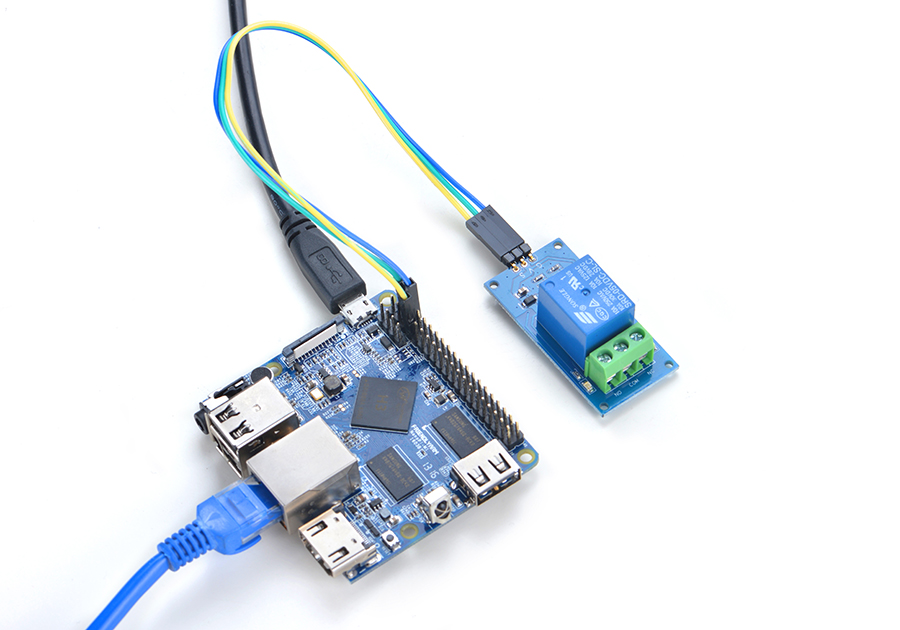
Connection Details:
| Matrix-Relay | NanoPi M1 |
| S | Pin7 |
| V | Pin4 |
| G | Pin6 |
4.2 Connect to NanoPi 2
Refer to the following connection diagram to connect the module to the NanoPi 2:
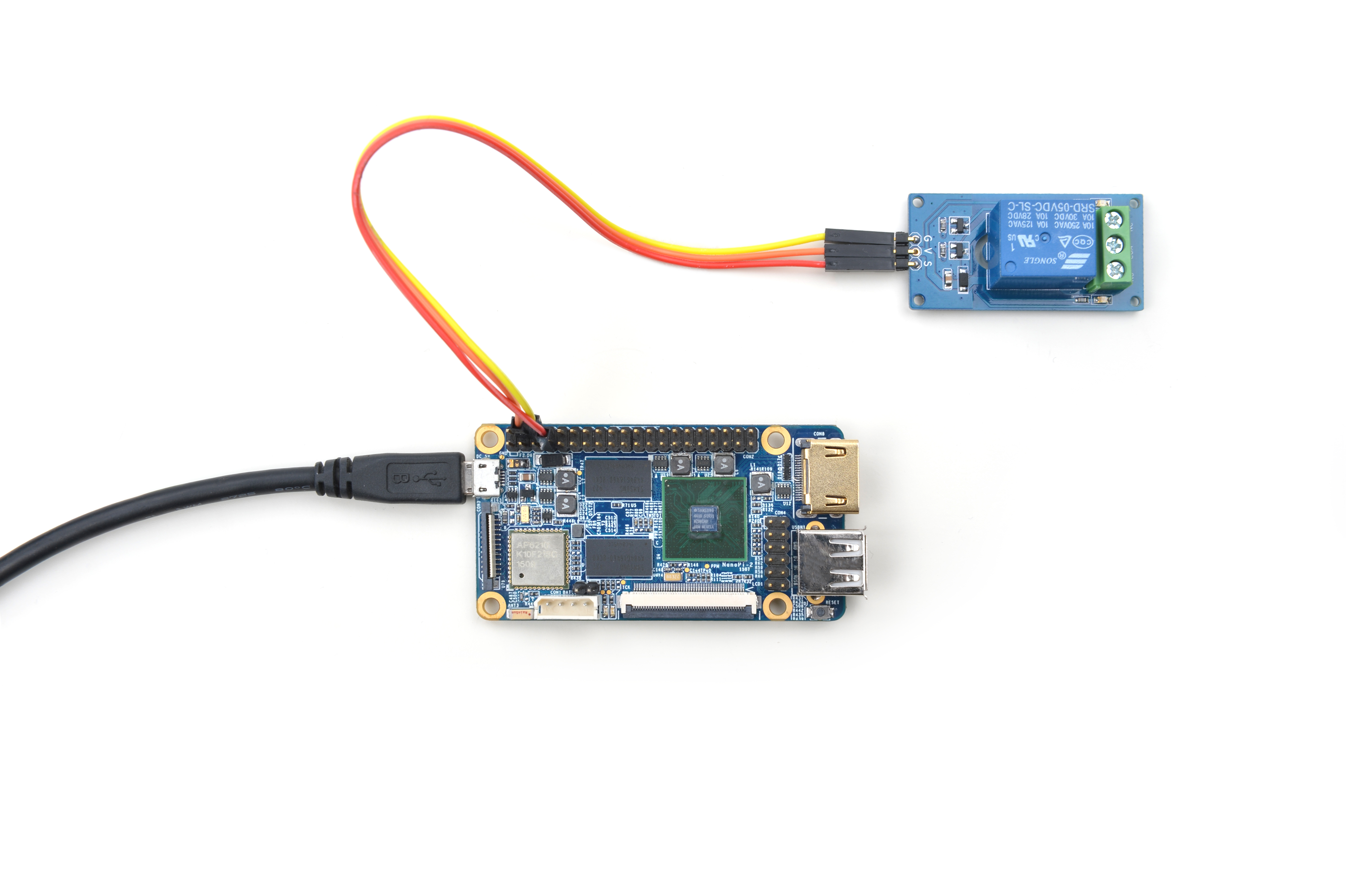
Connection Details:
| Matrix-Relay | NanoPi 2 |
| S | Pin7 |
| V | Pin4 |
| G | Pin6 |
4.3 Connect to NanoPi M2 / NanoPi 2 Fire
Refer to the following connection diagram to connect the module to the NanoPi M2/ NanoPi 2 Fire:
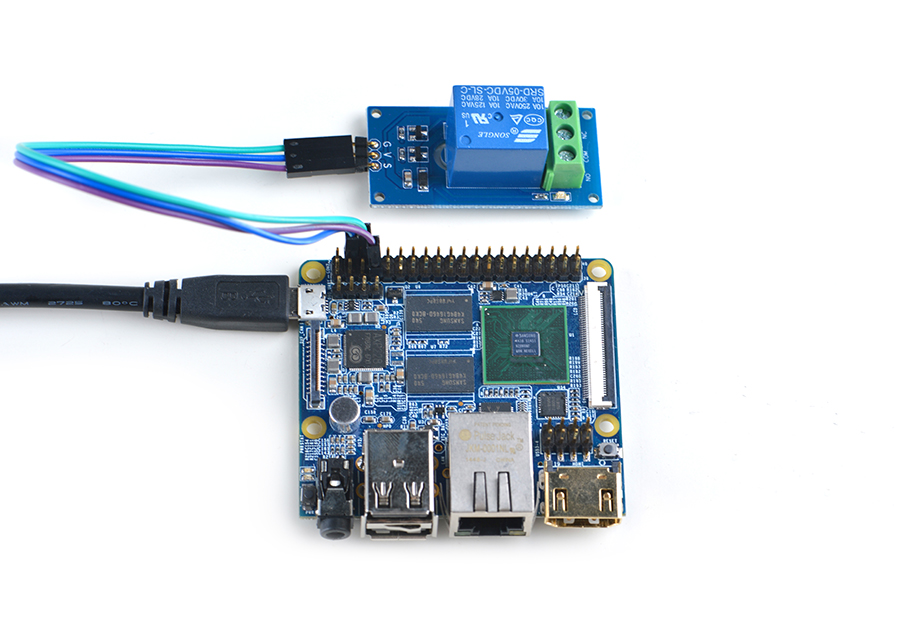
Connection Details:
| Matrix-Relay | NanoPi M2 |
| S | Pin7 |
| V | Pin4 |
| G | Pin6 |
4.4 Connect to NanoPC-T2
Refer to the following connection diagram to connect the module to the NanoPC-T2:
Matrix-Relay_NanoPC-T2
Connection Details:
| Matrix-Relay | NanoPC-T2 |
| S | Pin15 |
| V | Pin29 |
| G | Pin30 |
5 Compile & Run Test Program
Boot your ARM board with Debian and copy the matrix code:
$ apt-get update && apt-get install git $ git clone https://github.com/friendlyarm/matrix.git
If your cloning is done successfully a "matrix" directory will be generated.
Compile and install Matrix:
$ cd matrix $ make && make install
Run test program:
$ matrix-gpio_outNote: this module is not plug and play therefore before running the module please make sure it is connected to an ARM board.
Here is what you should observe:
1: gpio status change 2: gpio status change 3: gpio status change 4: gpio status change 5: gpio status change
6 Code Sample
This Matrix code sample can work with all the ARM boards mentioned in this module's wiki. The name of this code sample is "matrix-gpio_out". Here is its source code:
int main(int argc, char ** argv) { int pin = GPIO_PIN(7); int i, value, board; int ret = -1; if ((board = boardInit()) < 0) { printf("Fail to init board\n"); return -1; } if (board == BOARD_NANOPI_T2) pin = GPIO_PIN(15); if (argc == 2) pin = GPIO_PIN(atoi(argv[1])); if ((ret = exportGPIOPin(pin)) == -1) { printf("exportGPIOPin(%d) failed\n", pin); } if ((ret = setGPIODirection(pin, GPIO_OUT)) == -1) { printf("setGPIODirection(%d) failed\n", pin); } for (i = 0; i < STATUS_CHANGE_TIMES; i++) { if (i % 2) { value = GPIO_HIGH; } else { value = GPIO_LOW; } if ((ret = setGPIOValue(pin, value)) > 0) { printf("%d: GPIO_PIN(%d) value is %d\n", i+1, pin, value); } else { printf("setGPIOValue(%d) failed\n", pin); } sleep(1); } unexportGPIOPin(pin); return 0; }
For more details about this APIs called in this code sample refer to Matrix API reference manual
7 Resources
8 Update Log
8.1 Feb-19-2016
- Added Section 5
8.2 June-23-2016
- Re-organized and simplified wiki
